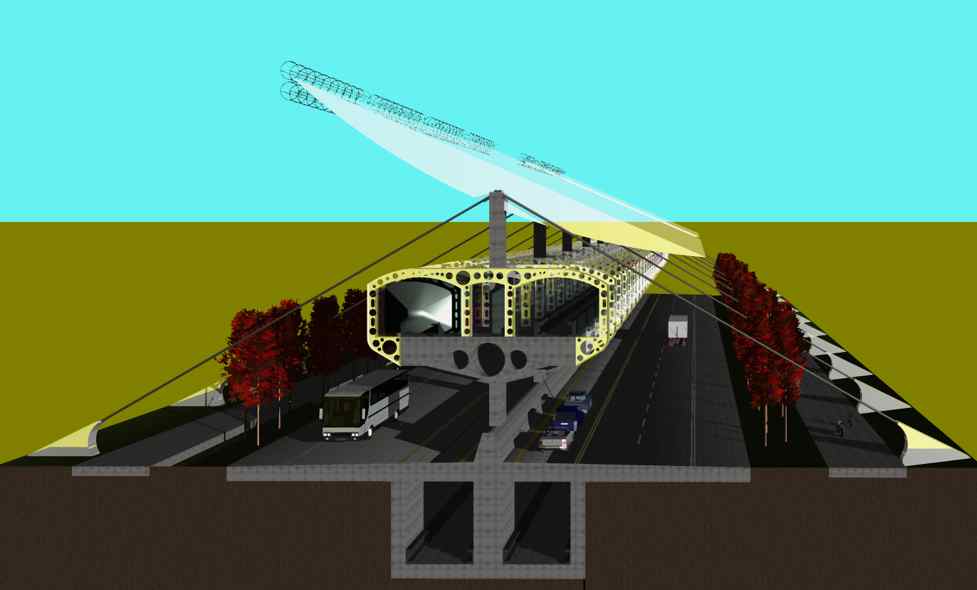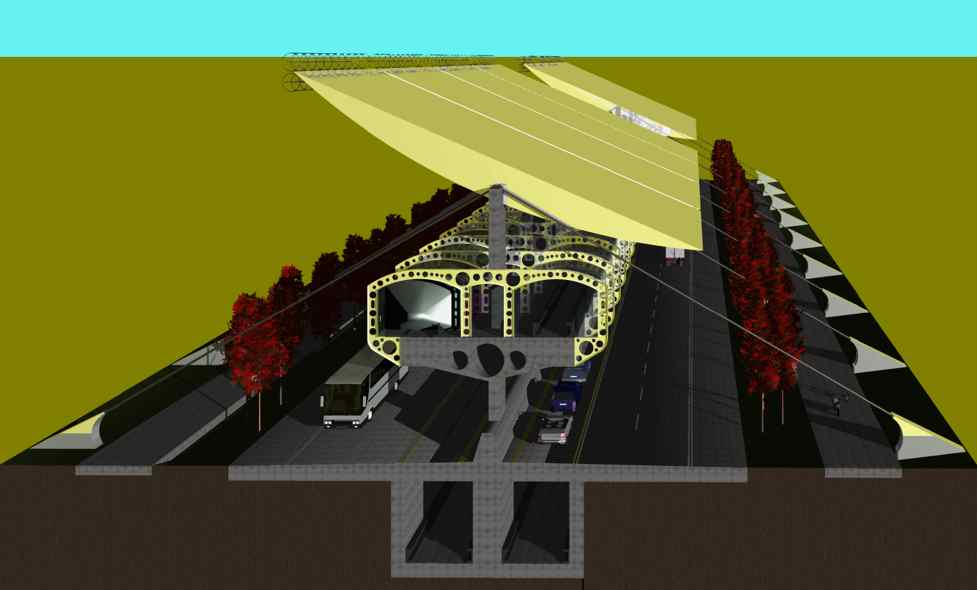Using land currently foreordained only for freeways and our edacious, gas-guzzling, carbon-polluting automobiles, the HYBRID CORRIDOR expands the benefit to include throughways for many different forms of transportation (including personal cars); systems for conveying, broadcasting, and receiving all manner of au courant communication; and mechanisms for the collection and distribution of greenenergy.
There are a significant number of Communication Network/Transportation Technology advances that serve to underscore the viability of building a multifunctional transportation corridor. Initially, the best location for such a system utilizes the freeway rights-of-way that connect Houston, Texas to Atlanta, Georgia, with interjacent nodes at Baton Rouge, Louisiana; New Orleans, Louisiana; Biloxi, Mississippi; Mobile, Alabama; and Montgomery, Alabama. There are several excellent reasons for choosing this route: 1. It connects two of the largest U.S. metropolitan areas, one with the other, with beneficial adjunct service to some very culturally distinct and, therefore, key U.S. cities — most notably New Orleans and Biloxi. 2. It provides an additional impetus in the rebuilding of New Orleans. 3. It positively impacts the State of Mississippi, the poorest State in the Union. 4. It makes use of land already used for transportation purposes. 5. It provides a lateral exit corridor during times of impending hurricane evacuation for most cities along the gulf coast. 6. It makes use of intense year-round sun exposure to drive EV solar panels. 7. It makes use of on-shore breezes and directional winds to propel wind turbines. 8. It provides a high-speed distribution network from several key southern ports — Mobile, New Orleans, Biloxi and Houston — that then interface with other transportation networks — the Mississippi River and north-bound freeway systems.
Any one facet of the project in a stand-alone scenario is not economically viable; combined, however, the entire project becomes profitable and feasible. The ideal platform for building this network involves a government-private enterprise joint venture, whereby government partners with several industry key players — transport/shipping firms, people-mover firms (airlines come to mind), utility companies, communication companies, and real-estate developers.
All sections of the project could be built concurrently, employing myriad planners, architects, engineers, contractors, laborers, graphic designers, and all of the sub-consultant, sub-supply manufacturing outfits entailed therein. The finished product would provide additional labor requirements for shipping companies, retailers, hoteliers, restaurateurs, travel companies and all of their individual suppliers.
Who, besides the taxpayer, benefits? 1. The casual freeway user. Automobile drivers and their families benefit from many different viewpoints — a very safe driving environment (roads lit at night; traffic control; an express lane for those who want to pay a bit more to travel faster; hands-free driving for those vehicles properly equipped); WiFi computer access; all stations radio and television access; infrastructure for alternative fuel vehicles; convenient and safe travel rest-stops). 2. Transport companies. Means for express shipping of containers and smaller packages that can be moved from Houston to Atlanta in 1 1/2 hours (shorter times for all the nodes in between).
Individual components of the Communication/Network/Transportation Complex include: 1. A six-lane (3 in each direction) freeway for conventional traffic, embedded with magnetic guidance technology strips that enable a high-speed express lane (80 mph — toll charges apply for its use). 2. Two sub-freeway rectangular cargo tubes (one in each direction) that use mag-lev technology in conjunction with pneumatic movement technology to provide rapid deployment of standard shipping containers at speeds up to 500 miles per hour. 3. Two Mag-Lev elevated train routes (one in each direction — on a continuous loop between Houston and Atlanta) that transport people and their personal luggage with stops at all nodes along the way, enabling speeds up to 350 miles per hour. 4. One mag-lev-pneumatic tube that enables a specially designed pod to transport “local”, smaller cargo between route nodal points, at speeds up to 500 miles per hour. 5. A fiber-optics/electronics “chase” that connects all electronic components on the system with nodal cities. 6. A super-conducting (liquid-nitrogen cooled) power transmission chase that will form one portion of a nation-wide grid, where power is moved efficiently. Parts of this chase will also be used for conducting electricity from system solar cells and wind turbines. 7. A fiber-optics camera grid that monitors the entire system over its complete length. 8. A wireless mesh network affixed to the underside of the solar panel network. 9. Intermittent satellite signal receptors at breaks in the solar array (roughly every 500 meters) to receive satellite communication signals. 10. holographic projectors to display 3-d advertising, PSAs, and travel information along the entire route. 11. Rest-stop service outlets at 60 mile intervals in both directions. 12. A “hurricane fence” to prevent debris from blowing onto the right-of way; also prevents wild animals from accessing the freeway.
There will be several income streams that together will combine to make the project self-sustaining and commercially viable. They include: 1. Express lane toll fees (these fees will be billed to users based on the license plate registration of vehicles using the service). 2. Transport truck toll fees (these fees, too, will be billed automatically from recorded information from overhead cameras). All passenger vehicles in the non-express lanes will otherwise be able to travel toll-free. 3. Cargo fees for use of the maglev/pneumatic transport tubes. 4. Mag-Lev Passenger Train fares. 5. Fiber-optic cable tolls. 6. Power-Grid fees. 7. Mesh network user fees for content providers. 8. Satellite service provider fees. 9. Advertising fees for companies using the holographic signs. 10. Fees related to the rest-stops — leasing fees for restaurants, retail stores, commercial businesses and hotels; service fees for battery recharging (electric and hybrid-electric vehicles) and for compressed air and hydrogen fuel tanks (air and hydrogen-powered vehicles).
SaveSave



